Random Matrix
Theory and Wireless
Communications
Antonia M. Tulino
Dept. Ingegneria Elettronica e delle Telecomunicazioni
Universit´a degli Studi di Napoli ”Federico II”
Naples 80125, Italy
atulino@ee.princeton.edu
Sergio Verd´u
Dept. Electrical Engineering
Princeton University
Princeton, New Jersey 08544, USA
verdu@princeton.edu
�
Foundations and Trends TM in
Communications and Information Theory
Published, sold and distributed by:
PO Box 179
2600 AD Delft
The Netherlands
Tel: +31-6-51115274
www.nowpublishers.com
sales@nowpublishers.com
in North America:
now Publishers Inc.
PO Box 1024
Hanover, MA 02339
USA
Tel. +1-781-985-4510
Printed on acid-free paper
ISSNs: Paper version 1567-2190; Electronic version 1567-2328
c 2004 A.M. Tulino and S. Verd´u
All rights reserved. No part of this publication may be reproduced,
stored in a retrieval system, or transmitted in any form or by any
means, mechanical, photocopying, recording or otherwise, without prior
written permission of the publishers.
Now Publishers Inc. has an exclusive licence to publish this mate-
rial worldwide. Permission to use this content must be obtained from
the copyright licence holder. Please apply to now Publishers, PO Box
179, 2600 AD Delft, The Netherlands; www.nowpublishers.com; e-mail:
sales@nowpublishers.com
Printed in Great Britain by Antony Rowe Limited.
�
Foundations and Trends™ in
Communications and Information Theory
Vol 1, No 1 (2004) 1-182
© 2004 A.M. Tulino and S. Verd´u
Random Matrix
Theory and Wireless
Communications
Antonia M. Tulino1, Sergio Verd´u2
1 Dept. Ingegneria Elettronica e delle Telecomunicazion, i Universita degli Studi di
Napoli “Federico II”, Naples 80125, Italy
2 Dept. Electrical Engineering, Princeton University, Princeton, New Jersey 08544,
USA
Abstract
Random matrix theory has found many applications in physics, statis-
tics and engineering since its inception. Although early developments
were motivated by practical experimental problems, random matrices
are now used in fields as diverse as Riemann hypothesis, stochastic
differential equations, condensed matter physics, statistical physics,
chaotic systems, numerical linear algebra, neural networks, multivari-
ate statistics, information theory, signal processing and small-world
networks. This article provides a tutorial on random matrices which
provides an overview of the theory and brings together in one source
the most significant results recently obtained. Furthermore, the appli-
cation of random matrix theory to the fundamental limits of wireless
communication channels is described in depth.
�
Table of Contents
Section 1 Introduction
1.1 Wireless Channels
1.2 The Role of the Singular Values
1.3 Random Matrices: A Brief Historical Account
Section 2 Random Matrix Theory
2.1 Types of Matrices and Non-Asymptotic Results
2.2 Transforms
2.3 Asymptotic Spectrum Theorems
2.4 Free Probability
2.5 Convergence Rates and Asymptotic Normality
Section 3 Applications to Wireless Communications
3.1 Direct-Sequence CDMA
3.2 Multi-Carrier CDMA
3.3 Single-User Multi-Antenna Channels
3.4 Other Applications
Section 4 Appendices
4.1 Proof of Theorem 2.39
4.2 Proof of Theorem 2.42
4.3 Proof of Theorem 2.44
4.4 Proof of Theorem 2.49
4.5 Proof of Theorem 2.53
References
2
3
5
6
13
21
21
38
52
74
91
96
96
117
129
152
153
153
154
156
158
159
163
�
1
Introduction
From its inception, random matrix theory has been heavily influenced
by its applications in physics, statistics and engineering. The landmark
contributions to the theory of random matrices of Wishart (1928) [311],
Wigner (1955) [303], and Mar˘cenko and Pastur (1967) [170] were moti-
vated to a large extent by practical experimental problems. Nowadays,
random matrices find applications in fields as diverse as the Riemann
hypothesis, stochastic differential equations, condensed matter physics,
statistical physics, chaotic systems, numerical linear algebra, neural
networks, multivariate statistics, information theory, signal processing,
and small-world networks. Despite the widespread applicability of the
tools and results in random matrix theory, there is no tutorial reference
that gives an accessible overview of the classical theory as well as the
recent results, many of which have been obtained under the umbrella
of free probability theory.
In the last few years, a considerable body of work has emerged in the
communications and information theory literature on the fundamental
limits of communication channels that makes substantial use of results
in random matrix theory.
The purpose of this monograph is to give a tutorial overview of ran-
3
�
4
Introduction
dom matrix theory with particular emphasis on asymptotic theorems
on the distribution of eigenvalues and singular values under various as-
sumptions on the joint distribution of the random matrix entries. While
results for matrices with fixed dimensions are often cumbersome and
offer limited insight, as the matrices grow large with a given aspect
ratio (number of columns to number of rows), a number of powerful
and appealing theorems ensure convergence of the empirical eigenvalue
distributions to deterministic functions.
The organization of this monograph is the following. Section 1.1
introduces the general class of vector channels of interest in wireless
communications. These channels are characterized by random matrices
that admit various statistical descriptions depending on the actual ap-
plication. Section 1.2 motivates interest in large random matrix theory
by focusing on two performance measures of engineering interest: Shan-
non capacity and linear minimum mean-square error, which are deter-
mined by the distribution of the singular values of the channel matrix.
The power of random matrix results in the derivation of asymptotic
closed-form expressions is illustrated for channels whose matrices have
the simplest statistical structure: independent identically distributed
(i.i.d.) entries. Section 1.3 gives a brief historical tour of the main re-
sults in random matrix theory, from the work of Wishart on Gaussian
matrices with fixed dimension, to the recent results on asymptotic spec-
tra. Section 2 gives a tutorial account of random matrix theory. Section
2.1 focuses on the major types of random matrices considered in the lit-
erature, as well on the main fixed-dimension theorems. Section 2.2 gives
an account of the Stieltjes, η, Shannon, Mellin, R- and S-transforms.
These transforms play key roles in describing the spectra of random
matrices. Motivated by the intuition drawn from various applications
in communications, the η and Shannon transforms turn out to be quite
helpful at clarifying the exposition as well as the statement of many
results. Considerable emphasis is placed on examples and closed-form
expressions. Section 2.3 uses the transforms defined in Section 2.2 to
state the main asymptotic distribution theorems. Section 2.4 presents
an overview of the application of Voiculescu’s free probability theory
to random matrices. Recent results on the speed of convergence to the
asymptotic limits are reviewed in Section 2.5. Section 3 applies the re-
�
1.1. Wireless Channels
5
sults in Section 2 to the fundamental limits of wireless communication
channels described by random matrices. Section 3.1 deals with direct-
sequence code-division multiple-access (DS-CDMA), with and without
fading (both frequency-flat and frequency-selective) and with single
and multiple receive antennas. Section 3.2 deals with multi-carrier code-
division multiple access (MC-CDMA), which is the time-frequency dual
of the model considered in Section 3.1. Channels with multiple receive
and transmit antennas are reviewed in Section 3.3 using models that
incorporate nonideal effects such as antenna correlation, polarization,
and line-of-sight components.
1.1 Wireless Channels
The last decade has witnessed a renaissance in the information theory
of wireless communication channels. Two prime reasons for the strong
level of activity in this field can be identified. The first is the grow-
ing importance of the efficient use of bandwidth and power in view
of the ever-increasing demand for wireless services. The second is the
fact that some of the main challenges in the study of the capacity of
wireless channels have only been successfully tackled recently. Fading,
wideband, multiuser and multi-antenna are some of the key features
that characterize wireless channels of contemporary interest. Most of
the information theoretic literature that studies the effect of those fea-
tures on channel capacity deals with linear vector memoryless channels
of the form
y = Hx + n
(1.1)
where x is the K-dimensional input vector, y is the N-dimensional
output vector, and the N-dimensional vector n models the additive
circularly symmetric Gaussian noise. All these quantities are, in gen-
eral, complex-valued. In addition to input constraints, and the degree
of knowledge of the channel at receiver and transmitter, (1.1) is char-
acterized by the distribution of the N × K random channel matrix H
whose entries are also complex-valued.
The nature of the K and N dimensions depends on the actual ap-
plication. For example, in the single-user narrowband channel with nT
�
6
Introduction
and nR antennas at transmitter and receiver, respectively, we identify
K = nT and N = nR; in the DS-CDMA channel, K is the number of
users and N is the spreading gain.
In the multi-antenna case, H models the propagation coefficients
between each pair of transmit-receive antennas. In the synchronous DS-
CDMA channel, in contrast, the entries of H depend on the received
signature vectors (usually pseudo-noise sequences) and the fading coef-
ficients seen by each user. For a channel with J users each transmitting
with nT antennas using spread-spectrum with spreading gain G and a
receiver with nR antennas, K = nTJ and N = nRG.
Naturally, the simplest example is the one where H has i.i.d. entries,
which constitutes the canonical model for the single-user narrowband
multi-antenna channel. The same model applies to the randomly spread
DS-CDMA channel not subject to fading. However, as we will see, in
many cases of interest in wireless communications the entries of H are
not i.i.d.
1.2 The Role of the Singular Values
Assuming that the channel matrix H is completely known at the re-
ceiver, the capacity of (1.1) under input power constraints depends on
the distribution of the singular values of H. We focus in the simplest
setting to illustrate this point as crisply as possible: suppose that the
entries of the input vector x are i.i.d. For example, this is the case
in a synchronous DS-CDMA multiaccess channel or for a single-user
multi-antenna channel where the transmitter cannot track the channel.
The empirical cumulative distribution function of the eigenvalues
(also referred to as the spectrum or empirical distribution) of an n × n
Hermitian matrix A is denoted by Fn
A defined as1
1{λi(A) ≤ x},
1
n
n
i=1
Fn
A(x) =
(1.2)
where λ1(A), . . . , λn(A) are the eigenvalues of A and 1{·} is the indi-
cator function.
A converges as n → ∞, then the corresponding limit (asymptotic empirical distribution
1 If Fn
or asymptotic spectrum) is simply denoted by FA(x).
�
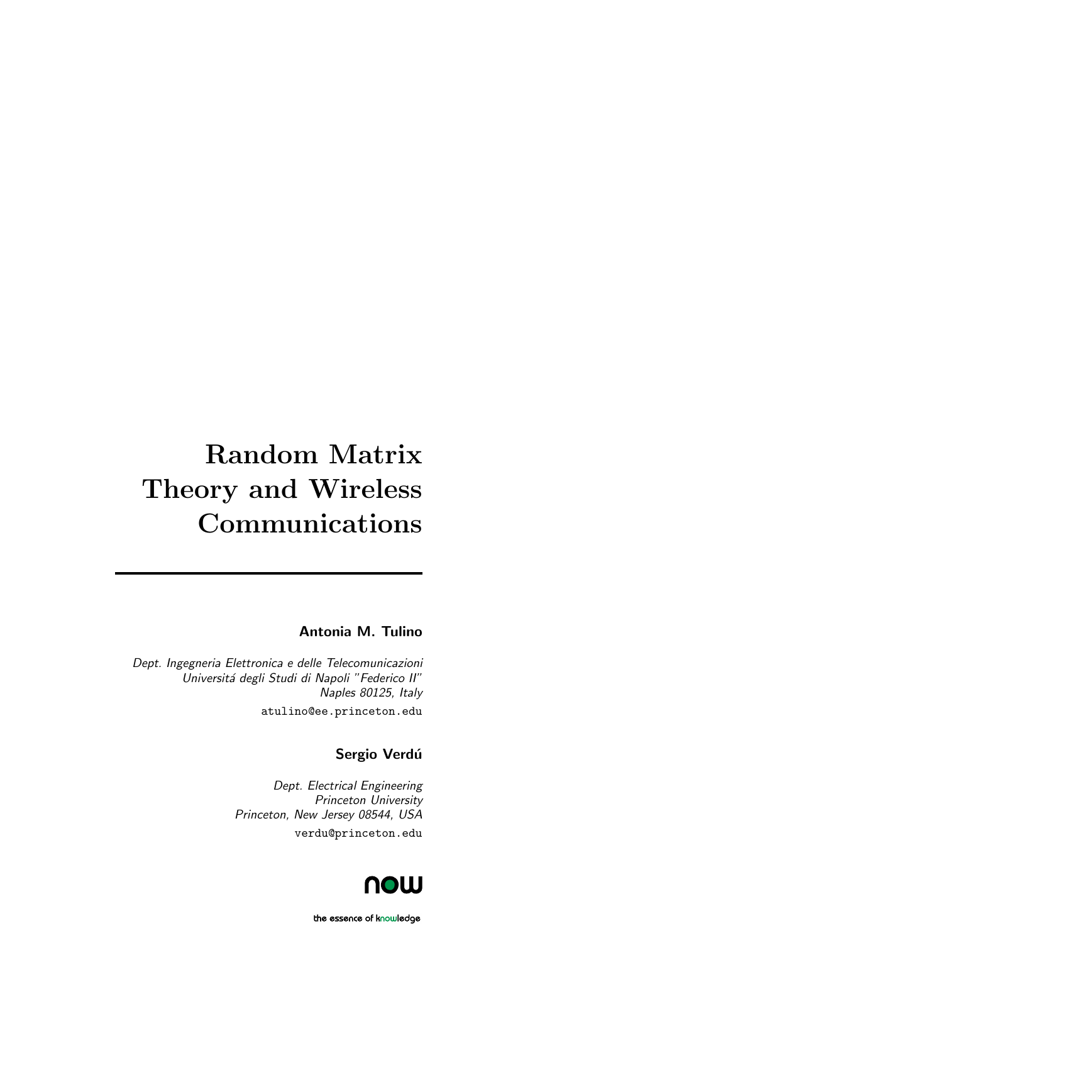

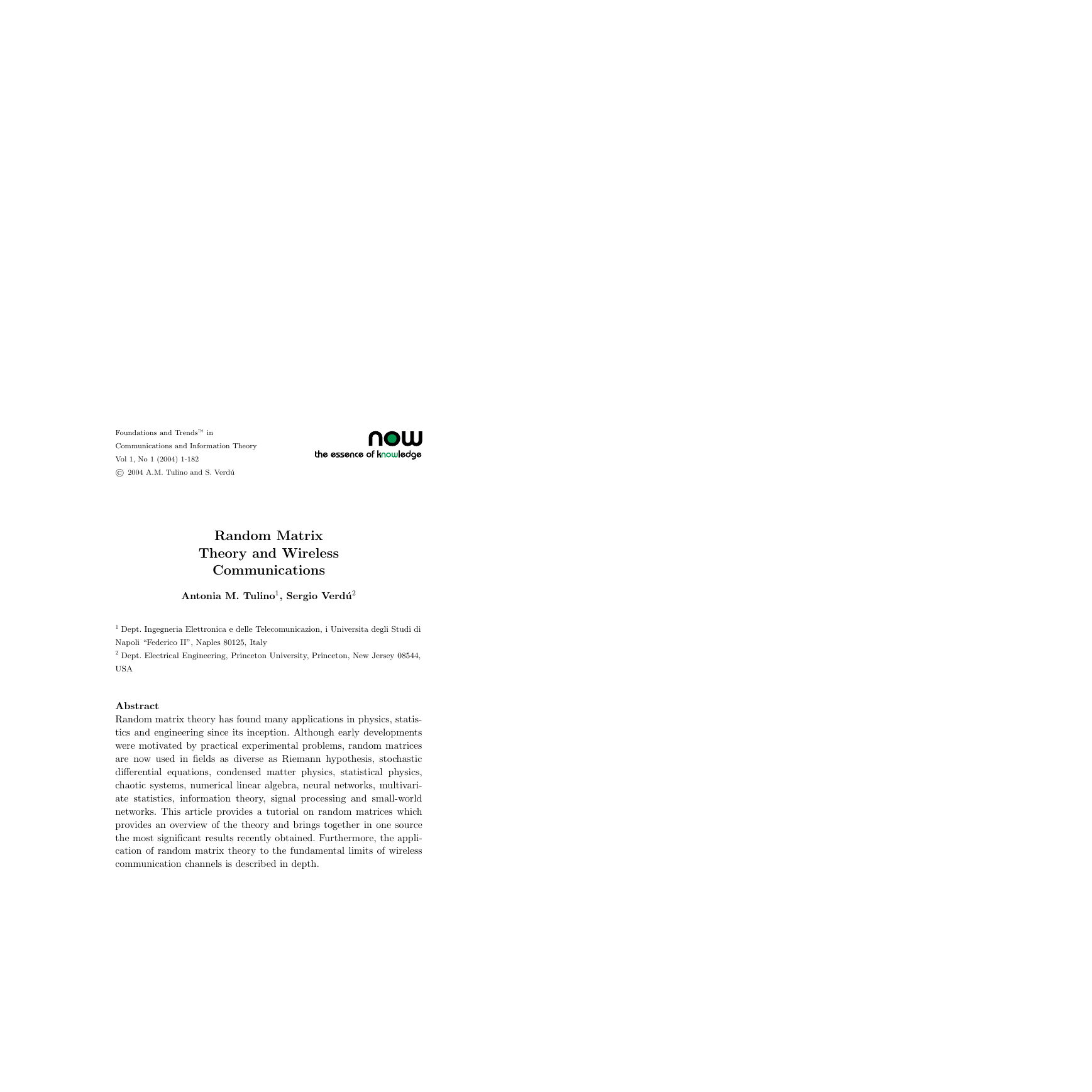
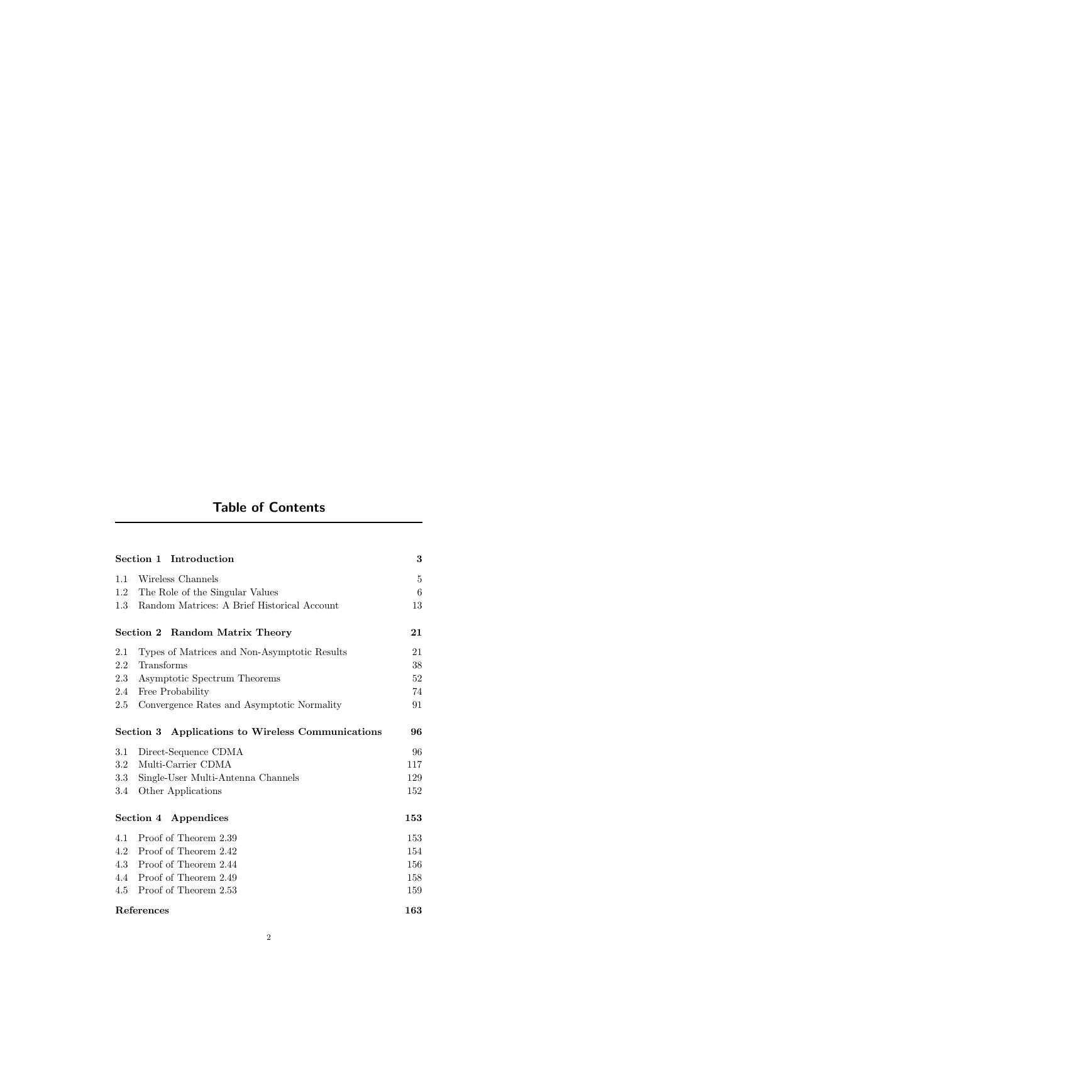
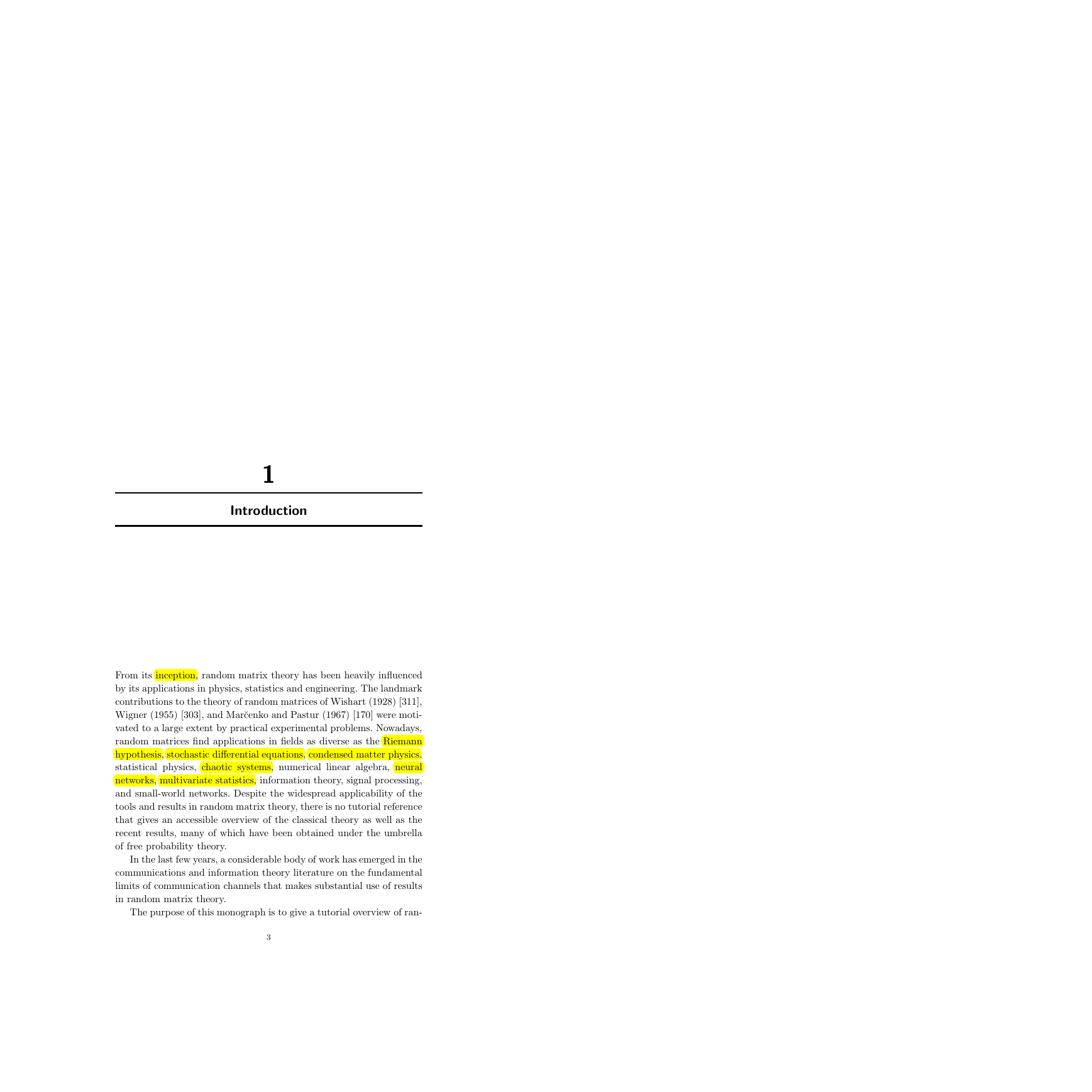
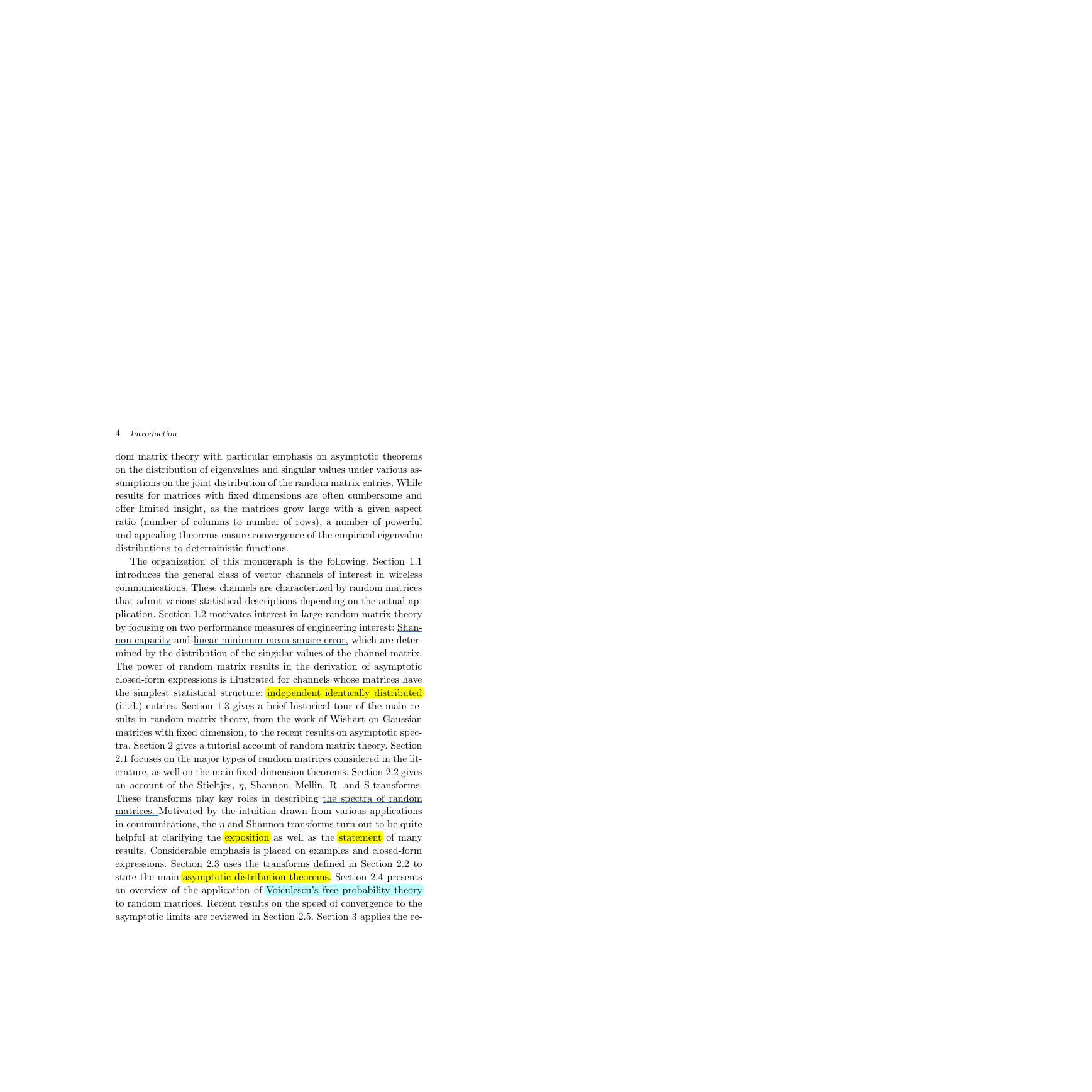
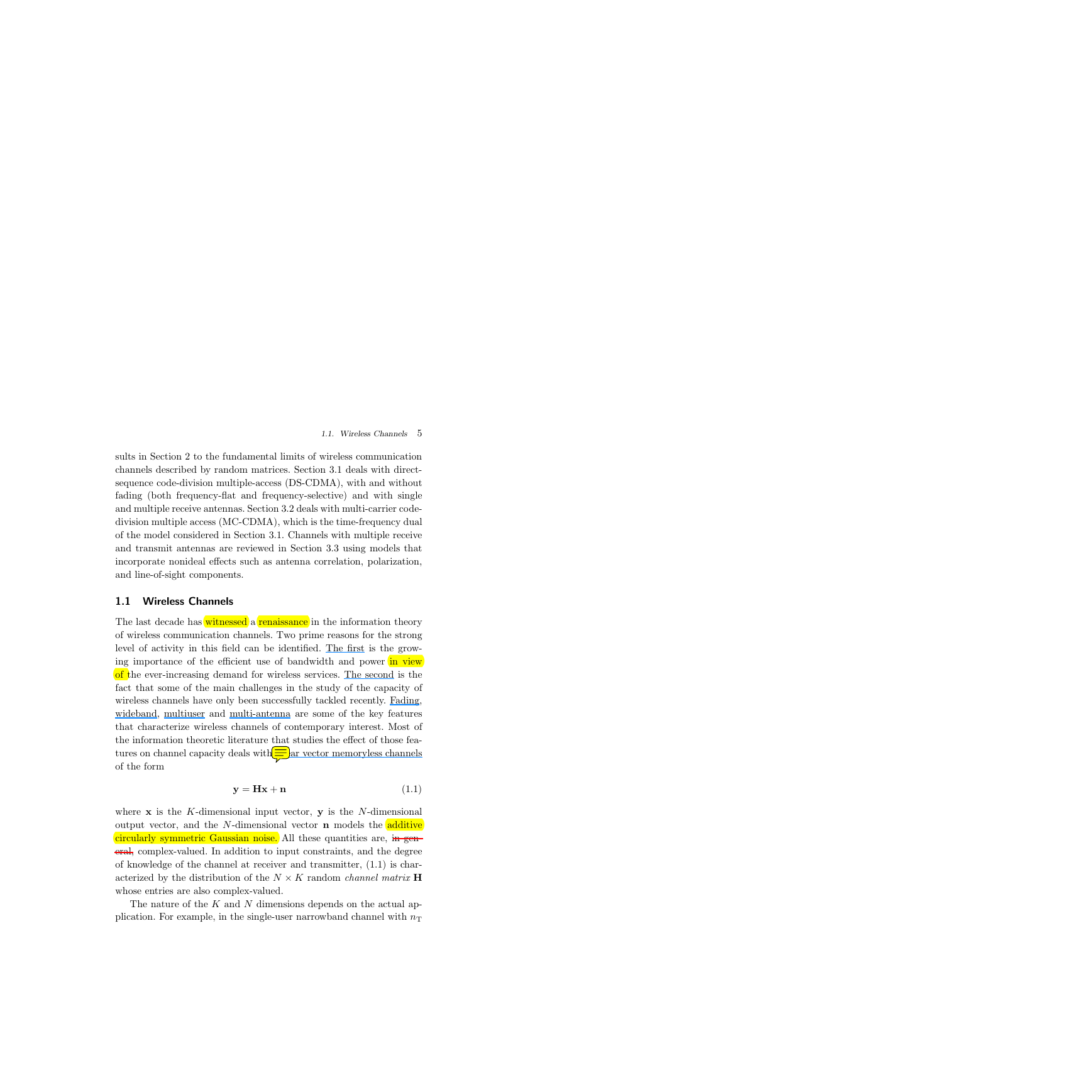
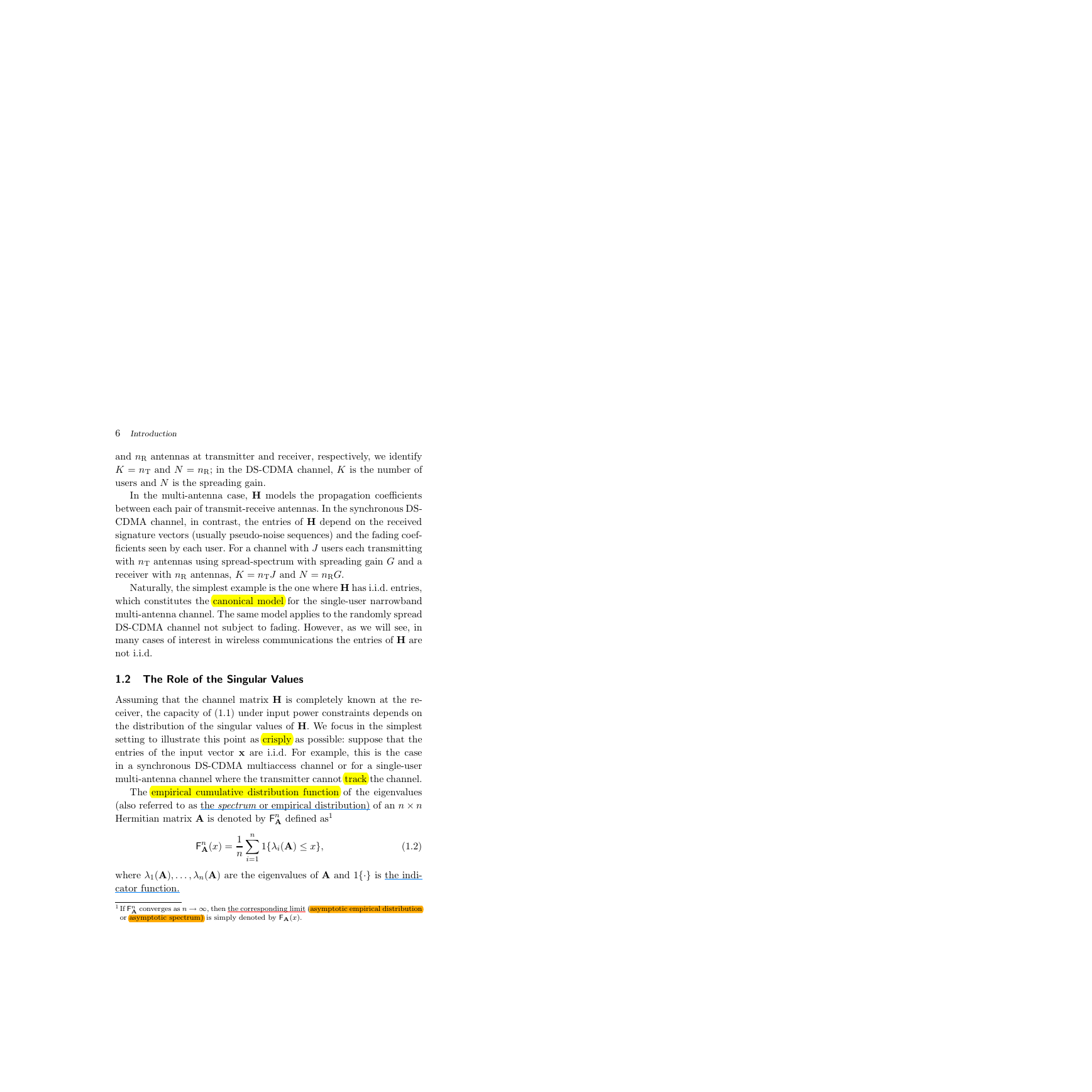








 2023年江西萍乡中考道德与法治真题及答案.doc
2023年江西萍乡中考道德与法治真题及答案.doc 2012年重庆南川中考生物真题及答案.doc
2012年重庆南川中考生物真题及答案.doc 2013年江西师范大学地理学综合及文艺理论基础考研真题.doc
2013年江西师范大学地理学综合及文艺理论基础考研真题.doc 2020年四川甘孜小升初语文真题及答案I卷.doc
2020年四川甘孜小升初语文真题及答案I卷.doc 2020年注册岩土工程师专业基础考试真题及答案.doc
2020年注册岩土工程师专业基础考试真题及答案.doc 2023-2024学年福建省厦门市九年级上学期数学月考试题及答案.doc
2023-2024学年福建省厦门市九年级上学期数学月考试题及答案.doc 2021-2022学年辽宁省沈阳市大东区九年级上学期语文期末试题及答案.doc
2021-2022学年辽宁省沈阳市大东区九年级上学期语文期末试题及答案.doc 2022-2023学年北京东城区初三第一学期物理期末试卷及答案.doc
2022-2023学年北京东城区初三第一学期物理期末试卷及答案.doc 2018上半年江西教师资格初中地理学科知识与教学能力真题及答案.doc
2018上半年江西教师资格初中地理学科知识与教学能力真题及答案.doc 2012年河北国家公务员申论考试真题及答案-省级.doc
2012年河北国家公务员申论考试真题及答案-省级.doc 2020-2021学年江苏省扬州市江都区邵樊片九年级上学期数学第一次质量检测试题及答案.doc
2020-2021学年江苏省扬州市江都区邵樊片九年级上学期数学第一次质量检测试题及答案.doc 2022下半年黑龙江教师资格证中学综合素质真题及答案.doc
2022下半年黑龙江教师资格证中学综合素质真题及答案.doc